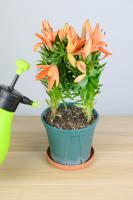Introduction
Plants are an essential part of our ecosystem and they provide us with air, food, shelter, and aesthetic beauty. Every plant needs care and maintenance to remain healthy, and one of the most crucial parts of plant care is cleaning their leaves. Dirty leaves are a breeding ground for pests and disease, which can harm the plant's growth and health. Many people prefer to use natural remedies for cleaning their plant leaves, and milk is one such remedy that is very effective. In this article, we will discuss how to clean plant leaves with milk.
Why Use Milk to Clean Plant Leaves
Milk is an excellent natural remedy for cleaning plant leaves because it is a gentle, non-toxic, and readily available substance. Milk contains enzymes that help to break down dirt and grime on the leaves, and it also contains lactic acid, which acts as a natural exfoliator. Additionally, milk is rich in calcium, which is an essential nutrient for plant growth and health. Using milk to clean plant leaves is an effective way to remove dust, dirt, and pests, and it also helps to nourish the plant.
Steps to Clean Plant Leaves with Milk
Cleaning plant leaves with milk is a simple and easy process that can be done in a few easy steps.
1. Choose the Right Milk: The first step is to choose the right milk to use. It is recommended to use whole milk, as it contains more fat and nutrients that are beneficial for the plant. Skim milk or low-fat milk may not be as effective.
2. Mix the Milk and Water: Next, mix one part milk with two parts water. You can also add a few drops of dish soap to the mixture, as it helps to break down the dirt and grime on the leaves.
3. Apply the Mixture: Dip a soft cloth or sponge into the milk and water mixture and gently wipe the plant leaves. Be sure to wipe both sides of the leaves and avoid rubbing too hard, as this can damage the delicate leaves.
4. Rinse the Leaves: After wiping the leaves, rinse them with clean water to remove any excess milk and dirt. You can use a spray bottle to mist the leaves with water or gently rinse them under a sink faucet.
5. Dry the Leaves: Use a clean cloth to pat the leaves dry. Avoid leaving the leaves wet for too long, as this can promote the growth of mold and mildew.
Tips for Cleaning Plant Leaves with Milk
- Avoid using milk to clean fuzzy or hairy leaves, as the milk may stick to the hairs and create a breeding ground for pests and disease.
- Test the milk mixture on a small portion of the leaves before applying it to the entire plant, to ensure that it does not cause damage or discoloration.
- Clean your plant leaves once a month to keep them healthy and free of pests and disease.
- Use a soft, clean cloth or sponge when wiping the leaves, as rough materials can scratch or damage the leaves.
- Do not use milk to clean succulent plants, as they are sensitive to moisture and can rot easily.
Conclusion
Cleaning plant leaves with milk is an effective and natural way to remove dirt, dust, and pests, and it also helps to nourish the plant. By following the steps outlined in this article and using the tips provided, you can keep your plant leaves healthy and beautiful. Remember to choose the right milk, mix it with water, apply it gently, rinse the leaves, and dry them thoroughly. With proper care and maintenance, your plants will thrive and add color and life to your home or garden.

 how many times do yo...
how many times do yo... how many planted tre...
how many planted tre... how many pine trees ...
how many pine trees ... how many pecan trees...
how many pecan trees... how many plants comp...
how many plants comp... how many plants can ...
how many plants can ... how many plants and ...
how many plants and ... how many pepper plan...
how many pepper plan...





























